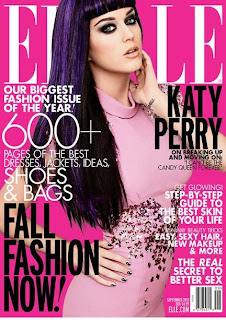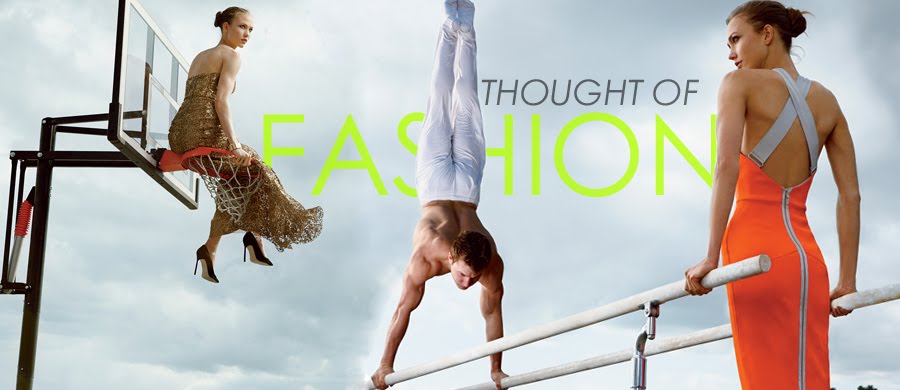What really influences the clothes you see in your favourite fashion magazine?
Media theory loves to analyse the level of objectivity in the news: whose voice is being heard, whose isn’t? Which viewpoint is more strongly presented? The main question academics are trying to answer is whether we can truly trust print media to be objective. (Or are they just a bunch of naughty capitalist Europeans who give you a very particular view of the world around you?)
Media theory loves to analyse the level of objectivity in the news: whose voice is being heard, whose isn’t? Which viewpoint is more strongly presented? The main question academics are trying to answer is whether we can truly trust print media to be objective. (Or are they just a bunch of naughty capitalist Europeans who give you a very particular view of the world around you?)
 |
| British ELLE. Click for more info. |
I’ve
heard people describe fashion magazines as shallow chunks of consumerism (not
in those exact words – but it was implied). And she (it was a she) has a point:
fashion magazines walk the thin line between being original and being a
shopping catalogue controlled by advertisers.
Fashion
magazines, like all media, need advertisers to survive. The difference between
a fashion magazine and newspaper is that every advertisement in a fashion
magazine is directly related to the subject matter of the magazine: fashion and
beauty. (A newspaper might have an ad for a holiday cruise that has nothing to
do with editorial content.)
Your
favourite fashion magazine relies on its advertisers to send them the content
which makes up the most important element of their editorial content. And so
the style incest begins.
You’re
a fashion editor styling up a shoot. You need to choose between two outfits,
one from a label which does not advertise in the magazine which pays your
salary, and one which does. You hate neither. Which do you pick?
 |
| British VOGUE. Click for more info. |
The
proof is of course in the cliché pudding. So I pulled out the September 2012
issues of American and British VOGUE, and American and British ELLE to do a
little experiment.
Quick
master-class for people who don’t know fashion magazines: The March and
September issues are the most important issues of the year as they showcase the
biggest spring and fall trends respectively. September has become more famous
because of R. J. Cutler’s documentary on the making of the September 2007 issue
of American VOGUE. September is usually the thickest issue of the year – the
one with the most advertisers. ELLE is the word’s biggest-selling fashion
magazine. VOGUE is known as the style Bible – an iconic brand that has existed
for over a century.
Your
usual September issue will feature about five fashion editorials, each
showcasing an important mood (we shan’t use the word trend – it’s too controversial) for the season. Although the
individual outfits will never consist of just one label, there is usually one
predominant label that defines the look. Example: shirt, trousers, and coat,
all Dolce & Gabbana. Shoes, Prada. Bag, Fendi. The winner: Dolce.
 |
| American ELLE. Click for more info. |
Going
through the magazines, I tried to discover whether the magazine’s top
advertisers were prominently featured in the fashion editorials. There is no
question that they would be featured: the ads represent prominent designers who
play important roles in creating the moods of the season. But are they being
overexposed? Are the voices of less rich but just as sartorially important
designers being left out? Are these advertisers shaping what we believe is fashionable?
Have
we been framed?
My
strategy was this: I made a list of every brand that placed an advertisement
between the cover and the first page of editorial content. Being a September
issue, this would be at least twelve brands and thirty pages. Then I counted
the number of outfits in the editorial pages, counted the number of those that
represented the top advertisers, and worked out a percentage.
The
results were surprisingly democratic.
US ELLE: 39% of
editorial outfits represent top advertisers.
US VOGUE: 53%
UK ELLE: 30%
UK VOGUE: 26%
Average
percentage of outfits in editorial pages representing top advertisers: 37%
 That’s
not so bad, is it? It’s not even half – one could hardly say these advertisers
are being given editorial preference. That said, every magazine featured at
least one outfit to represent each top advertiser. With the exception of
British VOGUE which neglected to feature Bottega Veneta and American ELLE which
failed to feature Guess (which places six pages – more than anyone else. Ouch.)
every top advertiser was accounted for.
That’s
not so bad, is it? It’s not even half – one could hardly say these advertisers
are being given editorial preference. That said, every magazine featured at
least one outfit to represent each top advertiser. With the exception of
British VOGUE which neglected to feature Bottega Veneta and American ELLE which
failed to feature Guess (which places six pages – more than anyone else. Ouch.)
every top advertiser was accounted for.
The
cover outfit on both ELLEs was by a top advertiser, while British Vogue
featured a designer that doesn’t even have an ad campaign. Over at American
VOGUE, they had top advertiser Marc Jacobs design a custom dress for the cover,
and featured him most prominently in editorial content with five main outfits.
Though their percentage is the highest, they also have the least number of
editorial outfits and the biggest list of advertisers – their biggest issue in
a hundred and twenty years hitting a record 916 pages.
 |
| American VOGUE. Click for more info. |
Of
course there are many different factors which determine whether or not and how
prominently a brand is featured editorially, but it would appear that these
magazines are not framing their readers. The top advertisers are acknowledged –
it probably goes without saying – but not overwhelmingly so.
The
politics of what it takes for one of aforementioned seasonal moods to be created is a whole other
story, and a much more shady one at that. But that’s an issue for another day.
For now, it would appear we can rest easy, knowing that the outfits occupying
those all-important pages of the fashion magazine giants are there because they
have the kind of style merit that makes them worthy of that place.
 |
| American VOGUE Creative Director Grace Coddington and Editor in Chief Anna Wintour in The September Issue. Click to see the trailer. |


No comments:
Post a Comment